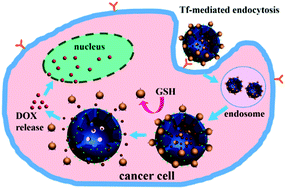Redox stimuli-responsive hollow mesoporous silica nanocarriers for targeted drug delivery in cancer therapy†
Abstract
In order to specifically deliver drugs into cancer cells with targeted recognition and controlled release, biocompatible hollow mesoporous silica nanocarriers with tumor-targeting and glutathione-responsive release dual properties were developed. These multifunctional nanocarriers were fabricated by anchoring transferrin on the surface of hollow mesoporous silica nanoparticles through disulfide bond conjugation, which could be cleaved in the presence of glutathione. In this case, transferrin acted as the gatekeeper to control the drug release, and as a tumor-targeting agent to improve drug accumulation at the tumor site simultaneously. The detailed investigations indicate that the anticancer drug (doxorubicin) release from the nanocarriers was strongly dependent on the concentration of glutathione. The capacity of the nanocarriers to selectively deliver doxorubicin to the tumor cells was demonstrated in vitro and in vivo. The doxorubicin-loaded nanocarriers showed enhanced inhibition of tumor growth and minimal side-effects in vivo compared to free doxorubicin. These redox stimuli-responsive nanocarriers that achieved a combination of tumor targeting and controlled drug release provide a promising platform for efficient cancer therapies.



 Please wait while we load your content...
Please wait while we load your content...